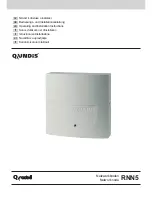
Publication date: Jan., 2009
Revision A1
139
3-19. QoS(Quality of Service) Configuration
The switch supports 5 kinds of QoS, are as follows, MAC Priority, 802.1p
Priority, IP TOS Priority, and DiffServ DSCP Priority. Port Based Priority has a
special name called VIP Port in the switch. Any packets enter VIP Port will have
highest transmitting priority. MAC Priority act on the destination address of MAC in
packets. VLAN tagged Priority field is effected by 802.1p Priority setting. IP TOS
Priority affects TOS fields of IP header, and you can find it has 8-bit SERVICE TYPE
field that specifies how the datagram should be handled. The field could be divided
into six subfields as follows, PRECEDENCE (3 bits), D-Type (Delay Priority, 1 bit ),
T-Type (Throughput Priority, 1bit), R-Type (Reliability Priority, 1bit ), M-Type
(Monetary Cost Priority, 1bit ), and UNUSED (1bit ).
User can randomly control these fields to achieve some special QoS goals.
When bits D, T, R, or M set, the D bit requests low delay, the T bit requests high
throughput, the R bit requests high reliability, and the M bit requests low cost.
DiffServ DSCP Priority act on DSCP field of IP Header. In the late 1990s, the
IETF redefined the meaning of the 8-bit SERVICE TYPE field to accommodate a set
of differentiated services (DS). Under the differentiated services interpretation, the
first six bits comprise a codepoint, which is sometimes abbreviated DSCP, and the
last two bits are left unused.
High Priority Packet streams will experience less delay into the switch. For
handing different priority packets, each egress port has designed up to 4 queues.
Each QoS is influenced by two scheduling, WRR (Weighted Round Robin) and
Strict Priority as well. When you finish to set the priority mapping to the queue, WRR
scheduling will distribute the bandwidth according to the weight you set for 4 queues
(queue 0 to queue 3). Another scheduling is Strict Priority dedicated for the function
named VIP Port of QoS. While we select some ports as the VIP Port, these ports
will own the highest transmitting priority in egress queue of the switch.
The QoS functions as we mentioned above are able to enabled at the same
time. But, the following precedence will decide whether these functions work or not.
1. Enable both VIP and TOS. Choose priorities of VIP and TOS.
2. Enable both VIP and DSCP. Choose priorities of VIP and DSCP.
3. Enable both TOS and DSCP. Choose "DSCP".
4. Enable both VIP and DSCP. Choose priorities of VIP and DSCP.
5. Enable both 802.1p and TOS. Choose "TOS".
6. Enable both 802.1p and DSCP. Choose "DSCP".
7. Enable both 802.1p and DSCP and TOS. Choose "DSCP".
8. Enable both 802.1p and DSCP and TOS and VIP. Choose priorities of VIP
and DSCP.
** VIP/DSCP > TOS > 802.1p (Final result)
















































